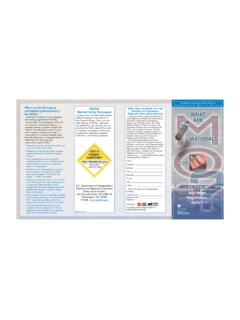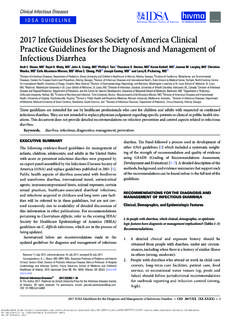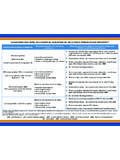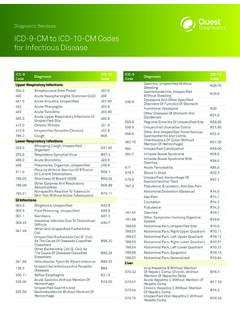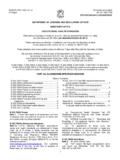Transcription of Infectious Subs. brochure
1 GUIDE TO CHANGESEFFECTIVE OCTOBER 1, 2006 FEDERAL REGISTERH azardous Materials: InfectiousSubstances; Harmonization With theUnited Nations Department of TransportationPipeline and Hazardous MaterialsSafety AdministrationInfectious subs . 10/2/2007 12:35 PM Page 1 Introduction .. 02 Why Are Infectious Substances Regulated in Transportation?.. 03 New Transportation Requirements forInfectious Substances .. 03 Changes to HMR; 49 CFR Parts 171, 172, 173, and 175 .. 03 New Classification System .. 04 Category A and Category B .. 06 New and Revised Definitions.. 08 Classification Process .. 10 Examples of Category A Infectious Substances:UN2814, Infectious Substances Affecting Humans.. 12 Examples of Category A Infectious Substances:UN2900, Infectious Substances Affecting Animals Only.. 14 Table of ContentsInfectious subs . 10/2/2007 12:35 PM Page 2 Classification Scenarios .. 16 General Information.. 18 Part 172 Hazardous Materials Table Changes .. 20 Part 172 Special Provisions, Hazardous MaterialsCommunications Changes.
2 22 Part 172 Security Plans .. 24 Part 173 General Requirements for Shipments and Packagings Changes .. 26 Packing and Labeling of Category A .. 28 Packing and Marking of Category B .. 30 Part 175 Carriage by Aircraft Changes .. 32 Where to Learn More .. back cover1 TRANSPORTINGINFECTIOUSSUBSTANCESSAFELYI nfectious subs . 10/2/2007 12:35 PM Page 1 IntroductionInfectious subs . 10/2/2007 12:35 PM Page 2 Final rule effective October 1, 2006 Voluntary compliance beginning July 2, 20063 WHY ARE Infectious SUBSTANCES REGULATED IN TRANSPORTATION? An Infectious substance is regulated as a hazardousmaterial under the Department of Transportation s(DOT s) Hazardous Materials Regulations (HMR; 49 CFRP arts 171-180). The HMR apply to any material DOTdetermines is capable of posing an unreasonable riskto health, safety, and property when transported incommerce. An Infectious substance must conform to allapplicable HMR requirements when offered for trans-portation or transported by air, highway, rail, or TRANSPORTATION REQUIREMENTS FORINFECTIOUS SUBSTANCESDOT s Pipeline and Hazardous Materials SafetyAdministration (PHMSA) published a final rule on June1, 2006, revising the requirements in the HMR appli-cable to the transportation of Infectious new requirements are effective October 1, UNDER THE NEW RULE APPLY TOPARTS 171, 172, 173, AND 175 OF THE HMR New classification system New and revised definitions Revised marking requirements Revised packaging requirements New shipping paper requirements New security plan requirements New carriage by aircraft requirementsInfectious subs .
3 10/2/2007 12:35 PM Page 34 New Classification SystemInfectious subs . 10/2/2007 12:35 PM Page 4 New classification criteria and packaging requirementsare now consistent with international standards andhelp clarify existing requirements to promote compli-ance. These revisions will ensure an acceptable level of safety for the transportation of Infectious substancesand facilitate domestic and international new classifications are based on criteria developedby the UN Committee of Experts working with theWorld Health Organization (WHO), the Centers forDisease Control and Prevention (CDC), medical profes-sionals, microbiologists, transportation professionals,and packaging technical experts. They are consistentwith the requirements contained in the 13th and 14theditions of the United Nations Recommendations for theTransport of Dangerous Goods (UN Recommendations),the 2005-2006 edition of the International CivilAviation Organization Technical Instructions for theSafe Transport of Dangerous Goods by Air (ICAOT echnical Instructions), and the International MaritimeOrganization (IMO) Dangerous Goods new HMR requirements establish a two-tieredclassification system for Infectious substances Category A and Category arenow consistentwith internationalstandards5 TRANSPORTINGINFECTIOUSSUBSTANCESSAFELY cation SystemInfectious subs .
4 10/2/2007 12:35 PM Page 5 DIVISION ( Infectious SUBSTANCE):Amaterial known or reasonably expected to contain apathogen. A pathogen is a micro-organism (includingbacteria, viruses, rickettsiae, parasites, fungi) or otheragent, such as a proteinaceous Infectious particle(prion), that can cause disease in humans or A:An Infectious substance in a formcapable of causing permanent disability or life-threatening or fatal disease in otherwise healthyhumans or animals when exposure to it occurs. Anexposure occurs when an Infectious substance isreleased outside of its protective packaging, resultingin physical contact with humans or must be based on the known medicalhistory or symptoms of the source patient or animal,endemic local conditions, or professional judgmentconcerning the individual circumstances of the sourcehuman or animal. Category A poses a higher degreeof risk than Category substances, affecting animals,UN2900 Infectious substances, affecting humans,UN2814 Proper shippingnames andidentificationnumbersCategory A and Category BInfectious subs .
5 10/2/2007 12:35 PM Page 6 CATEGORY B:An Infectious substance not in a formgenerally capable of causing permanent disability orlife-threatening or fatal disease in otherwise healthyhumans or animals when exposure to it occurs. Thisincludes Category B Infectious substances transportedfor diagnostic or investigational SHIPPING NAME AND IDENTIFICATIONNUMBER:Biological substance, Category B, UN3373 (The proper shipping names Diagnostic Specimen or Clinical Specimen may be used in place of Biologicalsubstance, Category B until January 1, 2007.)New classificationsystem:Category Aand Category B7 TRANSPORTINGINFECTIOUSSUBSTANCESSAFELYI nfectious subs . 10/2/2007 12:35 PM Page 78 Part 173 General Requirements for Shipmentsand PackagingsIn addition to Category A and Category B, there areother new and revised definitions in PRODUCT:A virus, therapeuticserum, toxin, antitoxin, vaccine, blood, blood component or derivative, allergenic product, or analogous product, or arsphenamine or derivative of arsphenamine (or any other trivalent arseniccompound) applicable to the prevention, treatment,or cure of a disease or condition of human beings or and Revised DefinitionsInfectious subs .
6 10/2/2007 12:36 PM Page 8 New definitionsDivision ( )9 TRANSPORTINGINFECTIOUSSUBSTANCESSAFELYCU LTURE:An Infectious substance containing apathogen that is intentionally propagated. Culturedoes not include a human or animal patient specimenas defined SPECIMEN:Human or animal materialscollected directly from humans or animals and trans-ported for research, diagnosis, investigational activi-ties, or disease treatment or prevention. Patientspecimen includes excreta, secreta, blood and itscomponents, tissue and tissue swabs, body parts,and specimens in transport media ( , transwabs,culture media, and blood culture bottles).EXCEPTIONS:A complete listing of materialsexcepted from regulation as Division materialsunder the HMR is found in (b). Infectious subs . 10/2/2007 12:36 PM Page 9 Classification Process10 Infectious subs . 10/2/2007 12:36 PM Page 1011 TRANSPORTINGINFECTIOUSSUBSTANCESSAFELYI nfectious subs . brochure REV 1/29/2008 9:24 AM Page 11 MICRO-ORGANISM Bacillus anthracis (cultures only)Brucella abortus (cultures only)Brucella melitensis (cultures only)Brucella suis (cultures only)Burkholderia mallei Pseudomonas mallei Glanders (cultures only)Burkholderia pseudomallei Pseudomonas pseudomallei (cultures only)Chlamydia psittaci avian strains (cultures only)Clostridium botulinum (cultures only)Coccidioides immitis (cultures only) Coxiella burnetti (cultures only)Crimean-Congo hemorrhagic fever virusDengue virus (cultures only)Eastern equine encephalitis virus (cultures only)Escherichia coli, verotoxigenic (cultures only) Ebola virusFlexal virusFrancisella tularensis (cultures only)Guanarito virusHantaan virusHantaviruses causing hemorrhagic fever with renal syndromeHendra virusHerpes B virus (cultures only)Human immunodeficiency virus (cultures only)Highly pathogenic avian influenza virus (cultures only)
7 Examples ofCategory A Infectious substances12 Examples of Category A Infectious SubstaUN2814, Infectious Substances Affecting HumansInfectious subs . 10/2/2007 12:36 PM Page 12 Japanese Encephalitis virus (cultures only)Junin virusKyasanur forest disease virusLassa virusMachupo virusMarburg virusMonkeypox virusMycobacterium tuberculosis (cultures only)Nipah virusOmsk hemorrhagic fever virusPoliovirus (cultures only)Rabies and other lyssaviruses (cultures only)Rickettsia prowazekii (cultures only)Rickettsia rickettsia (cultures only)Rift Valley fever virus (cultures only)Russian spring-summer encephalitis virus (cultures only)Sabia virusShigella dysenteriae type I (cultures only)Tick-borne encephalitis virus (cultures only)Variola virusVenezuelan equine encephalitis virus (cultures only)Vesicular stomatitis virus (cultures only)West Nile virus (cultures only)Yellow fever virus (cultures only)Yersinia pestis (cultures only)List provided asguidance onlyList is NOT all inclusive13 TRANSPORTINGINFECTIOUSSUBSTANCESSAFELY ctious Substances:Affecting HumansInfectious subs .
8 10/2/2007 12:36 PM Page 13 Examples of Category A Infectious SubstaUN2900, Infectious Substances Affecting Animals Infectious subs . 10/2/2007 12:36 PM Page 14 MICRO-ORGANISMA frican swine fever virus (cultures only)Avian paramyxovirus Type 1 Velogenic Newcastle diseasevirus (cultures only)Classical swine fever virus (cultures only)Foot and mouth disease virus (cultures only)Lumpy skin disease virus (cultures only)Mycoplasma mycoides Contagious bovine pleuropneumonia(cultures only)Peste des petits ruminants virus (cultures only)Rinderpest virus (cultures only)Sheep-pox virus (cultures only)Goatpox virus (cultures only)Swine vesicular disease virus (cultures only)List provided asguidance onlyList is NOT all inclusive15 Photo: Courtesy USDA-ARSTRANSPORTINGINFECTIOUSSUBSTANCES SAFELY ctious Substances:Affecting Animals OnlyInfectious subs . 10/2/2007 12:36 PM Page 15 Classification ScenariosSCENARIO 1 Appropriate classification: Infectious Substance,affecting humans, UN2814 SCENARIO 2 Appropriate classification: Infectious Substance,affecting animals, UN29001616A blood sample known orreasonably suspected to containEBOLA VIRUSNoYesInfectious Substance,affecting humans, UN2814 Does it meet the definitionof a Category A Substance?
9 YesDoes it meet the definitionof a Category A Substance?[See bulleted questions pg. 11][See bulleted questions pg. 11]A culture ofFOOT AND MOUTH DISEASENoInfectious Substance,affecting animals, UN2900 Infectious subs . 10/2/2007 12:36 PM Page 16 SCENARIO 3 Appropriate classification:Biological Substance,Category B, UN3373(unless transportedby private or contractcarrier by motor vehicle)SCENARIO 4 Appropriate classification:Not subject to the HazardousMaterials Regulations17 TRANSPORTINGINFECTIOUSSUBSTANCESSAFELYA blood sample taken from apatient known or suspected to havea Category B pathogen, such asHEPATITIS B or HIVNoNoNoBiological Substance,Category B, UN3373 Not subject to therequirements asDivision materialDoes it meet the definitionof a Category A Substance?Is it a patient sample transported by privateor contract carrier in a motor vehicle usedexclusively for these materials?A BLOOD SAMPLEnot known to contain pathogenscollected for routine testingNoNoNot subject to therequirements asDivision materialYesDoes it meet the definition of aCategory A or Category B Substance?
10 [See bulleted questions pg. 11][See bulleted questions pg. 11]Photos: Courtesy CDC and NIHI nfectious subs . 10/2/2007 12:36 PM Page 17 General Information18 Infectious subs . 10/2/2007 12:36 PM Page 18 Paragraph D. Exceptions for Certain ShipmentsFederal Register/Vol. 71, No. 106/June 2, 2006/page 32248. Specimen packages marked as Exempt humanspecimen or Exempt animal specimen accordingto the ICAO Technical Instructions are notregulatedunder the HMR. In the United States, the mark Exempt Human/Animal Specimen is an indicationthat there is no Infectious substance in the bearing these marks may be accepted byan air carrier that has made a business decision notto accept hazardous materials. and Incident must report any release of an Infectious substance(Category A or B) in any mode of transportation to theDepartment of Transportation. See for tele-phonic and for written report requirements. Exempt human specimen and Exempt animalspecimen Incident reporting19 TRANSPORTINGINFECTIOUSSUBSTANCESSAFELYI nfectious subs .

